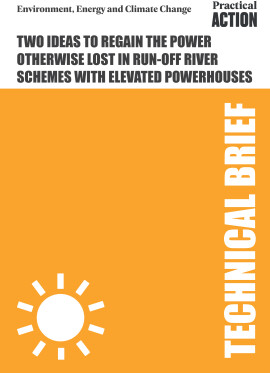
Low-cost Electrification
Affordable electricity installation for low-income households in developing countries
Electricity is highly desired by low-income households, but it is all too often only obtained by the richer people in developing countries. The tremendous sacrifices and high payments that low-income households are often prepared to make to obtain even small amounts indicate the importance that they attach to electricity. Low-cost Electrification looks at why, in most developing countries, efforts to provide electricity to poor households have had only limited success and recommends some appropriate solutions. This Working Paper draws on the experience of experts involved in low-cost electrification snd evidence collected from six developing countries. The paper contains a complete review of the problems faced by poor users which include high connection costs, high costs of house wiring, and houses failing to meet standard requirements, as well as a review of the constraints faced by power utilities such as high capital costs and high revenue-collection costs. The paper suggests a number of new and practical approaches, and ways to implement them, which can make electirifcation more economic for the utility, and spread the benefits of electrification more equitably across the social spectrum. Low-cost Electrification is part of the Intermediate Technology Working Papers series which is designed to make the information that Intermediate Technology is generating about technology and development accessible to a brader readership across the development sector.
Published: 1998
Pages: 48
eBook: 9781780442686
Paperback: 9781853394546
| Foreword | |||
|---|---|---|---|
| Acknowledgements | |||
| 1 Executive summary | |||
| 2 Background | |||
| 2.1 Uptake of electricity connections by low income households | |||
| 2.2 Reasons for providing electricity to low income households | |||
| 2.3 Electricity usage by low income households | |||
| 3 Financial viability | |||
| 3.1 Expenditure on electricity by low income households | |||
| 3.2 The cost to the utility of providing electricity to | |||
| domestic consumers | |||
| 3.3 Reducing the cost to the utility of providing electricity | |||
| to low income households | |||
| 4 Constraints faced by utilities | |||
| 4.1 High capital costs | |||
| 4.2 High revenue collection costs | |||
| 4.3 Low income from existing operation | |||
| 4.4 Insufficient generating capacity for additional consumers | |||
| 4.5 High connection costs to scattered homesteads | |||
| 4.6 Theft | |||
| 5 Problems faced by consumers | |||
| 5.1 High charge for initial connection | |||
| 5.2 High cost of house-wiring | |||
| 5.3 Uncertainty over electricity charges | |||
| 5.4 Safety standards | |||
| 5.5 Distance to payment centre | |||
| 5.6 Poor quality/reliability of supply | |||
| 6 Solutions | |||
| 6.1 Load limited supply | |||
| 6.1.1 General description | |||
| 6.1.2 Basic operation | |||
| 6.1.3 Load factor | |||
| 6.1.4 Cost | |||
| 6.1.5 Accuracy | |||
| 6.1.6 Advantages | |||
| 6.1.7 Disadvantages | |||
| 6.1.8 The way forward | |||
| 6.2 Reduced service connection costs | |||
| 6.3 Pre-fabricated wiring systems | |||
| 6.31 Wiring harnesses | |||
| 6.32 Ready boards | |||
| 6.3-3 Conclusions | |||
| 6.4 Credit | |||
| 6.5 Community involvement | |||
| 6.51 Local community involvement | |||
| 6.5.2 Cooperatives | |||
| 6.6 Prepayment meters | |||
| 6.7 Tariff reforms | |||
| 6.8 Revised safety standards | |||
| 7 Acceptability of solutions 28 | |||
| 8 Guidelines for utilities 30 | |||
| 9 Cost savings 31 | |||
| 9.1 Load limited supply 31 | |||
| 9.2 Pre-fabricated wiring systems 31 | |||
| 9.3 Community involvement 31 | |||
| 10 Further work 32 | |||
| 10.1 Improved channels of communication 32 | |||
| 10.2 Technical developments 32 | |||
| 10.3 Demonstration projects 32 | |||
| Appendix 1: Terms of reference 34 | |||
| Appendix 2: Organisations visited 34 | |||
| Appendix 3: Individuals consulted 36 | |||
| References 37 |
Nigel Smith
Dr Nigel Smith is an independent engineering consultant with experience in low-cost electrification in developing countries.





